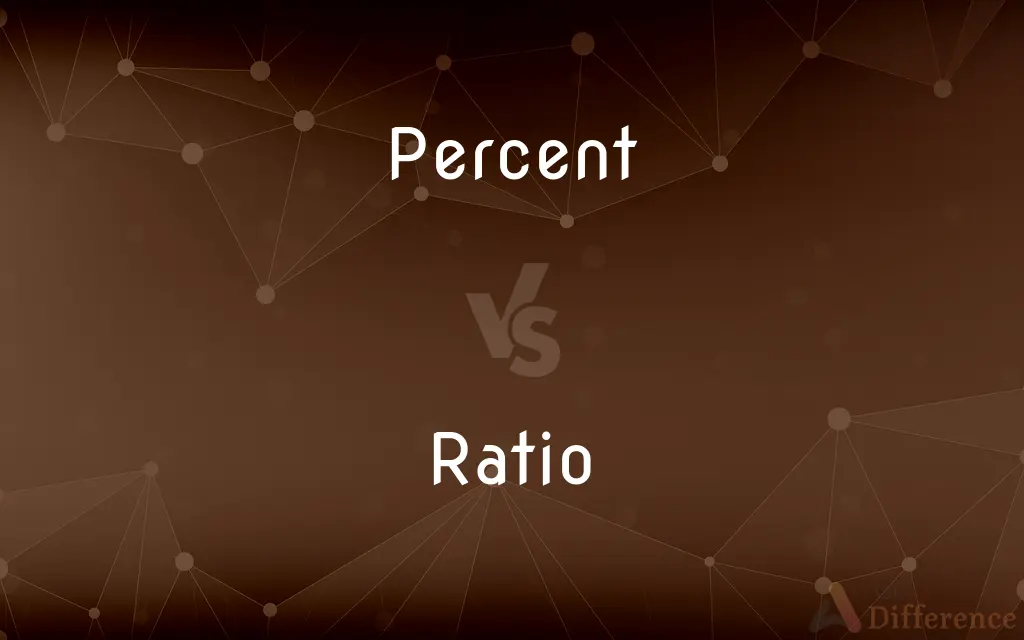Percent vs. Ratio — What's the Difference?
Edited by Tayyaba Rehman — By Urooj Arif — Updated on April 4, 2024
Percent expresses a fraction of 100, while ratio represents the relative size of two quantities.

Difference Between Percent and Ratio
Table of Contents
ADVERTISEMENT
Key Differences
Percent is a mathematical term used to describe a quantity as a fraction of 100, indicating how many parts out of a hundred a certain value represents. Ratios, on the other hand, compare two quantities to show their relative sizes, not necessarily out of a hundred.
While percents are often used to describe changes in quantities, proportions, or to compare differences within a whole, ratios provide a direct comparison between two quantities, illustrating how much of one thing there is compared to another. Percentages are typically represented with the "%" symbol, conveying parts per hundred, whereas ratios are expressed using the ":" symbol or the word "to", highlighting the comparative nature between two numbers.
The application of percent is widespread in financial contexts, statistics, and daily life to convey information in a universally understood format—parts per hundred. Ratios, however, are more versatile in their application, from comparing quantities in recipes, to expressing odds in probabilities, or representing scale in models and maps.
Percents are inherently tied to a base of 100, making them particularly useful for expressing proportions and fractions in an easily digestible format. Ratios do not adhere to this base-100 constraint, offering a more flexible comparison that can articulate any relationship between numbers, regardless of scale or magnitude.
Comparison Chart
Definition
A part per hundred of anything.
A relationship between two numbers showing how many times the first number contains the second.
ADVERTISEMENT
Expression
Represented by the "%" symbol.
Expressed as "a:b" or "a to b".
Use
To express fractions, proportions, or changes as parts of 100.
To compare quantities directly, without a fixed base.
Example
50% means 50 out of 100.
The ratio 1:2 means for every 1 of the first item, there are 2 of the second.
Application
Common in percentages, discounts, and statistics.
Used in comparisons, recipes, scales, and more.
Compare with Definitions
Percent
Applied in financial contexts to indicate discounts or sales.
All items are 25% off this weekend.
Ratio
Represents the proportionate relationship between parts.
The gear ratio in the machine is 4 to 1.
Percent
A measure that quantifies a number as a fraction of 100.
An 80% grade means 80 points out of a possible 100.
Ratio
Illustrates scale, as in maps or models.
The map's scale is a ratio of 1:100,000.
Percent
Indicates growth or decline in investments over time.
My portfolio has increased by 10% this year.
Ratio
Used in mathematics to solve problems involving proportions.
The ratio of students to teachers is 20:1.
Percent
Useful in comparing the relative size of a part to a whole.
The project is 50% complete.
Ratio
Can denote odds in gambling or predictions.
The odds of winning are at a ratio of 5 to 1.
Percent
Used to express probability, statistics, or interest rates.
There's a 30% chance of rain today.
Ratio
A comparison of two numbers or quantities.
The ratio of water to flour in the recipe is 2:1.
Percent
Out of each hundred; per hundred.
Ratio
In mathematics, a ratio indicates how many times one number contains another. For example, if there are eight oranges and six lemons in a bowl of fruit, then the ratio of oranges to lemons is eight to six (that is, 8∶6, which is equivalent to the ratio 4∶3).
Percent
Pl. percent also per cent One part in a hundred
The report states that 42 percent of the alumni contributed to the endowment. Also called per centum.
Ratio
The quantitative relation between two amounts showing the number of times one value contains or is contained within the other
The ratio of men's jobs to women's is 8 to 1
Percent
Pl. percents A percentage or portion
She has invested a large percent of her salary.
Ratio
Relation in degree or number between two similar things.
Percent
Percents Chiefly British Public securities yielding interest at a specified percentage.
Ratio
The relative value of silver and gold in a currency system that is bimetallic.
Percent
Paying or demanding interest at a specified percentage
A 2.25 percent checking account.
Ratio
(Mathematics) A relationship between two quantities, normally expressed as the quotient of one divided by the other; for example, the ratio of 7 to 4 can be written 7:4 or 7/4. A ratio can often also be expressed as a decimal or percentage.
Percent
For every hundred (used with preceding numeral to form a noun phrase expressing a proportion).
Ratio
A number representing a comparison between two named things.
Percent
A percentage, a proportion (especially per hundred).
Only a small percent attain the top ranks
Ratio
(arithmetic) The relative magnitudes of two quantities (usually expressed as a quotient).
Percent
One part per hundred; one percent.
Ratio
(legal) ratio decidendi
Percent
The percent sign, %.
Ratio
(Internet) The number of comments to a post or other expression on social media relative to the number of likes; a high ratio suggests disagreement with the contents of the original post.
Percent
An annuity or security with a certain fixed and guaranteed annual percentage rate of return or percentage dividend.
Ratio
To respond to a post or message on social media in a greater number than the number of likes the post receives, especially to condemn or mock the original poster.
The politician's post was quickly ratioed due to its controversial nature.
Percent
A proportion multiplied by 100
Ratio
Indicates disagreement with a post the user disagrees with or dislikes.
L + ratio
Ratio
The relation which one quantity or magnitude has to another of the same kind. It is expressed by the quotient of the division of the first by the second; thus, the ratio of 3 to 6 is expressed by
Ratio
Hence, fixed relation of number, quantity, or degree; rate; proportion; as, the ratio of representation in Congress.
Ratio
The relative magnitudes of two quantities (usually expressed as a quotient)
Common Curiosities
What is the difference between percent and percentage?
Percent refers to a specific part per hundred, while percentage is the amount or proportion represented as a percent.
Can ratios be converted to percents?
Yes, by finding the equivalent fraction out of 100, ratios can be expressed as percents.
Can a ratio represent parts of a whole like percent?
Yes, ratios can express parts of a whole but in a direct comparison between two quantities, not necessarily out of 100.
Are percents always less than 100?
No, percents can be greater than 100 when representing quantities larger than the whole.
What does a 1:1 ratio mean?
A 1:1 ratio means that there are equal quantities of two items being compared.
How do you find a percent of a number?
Multiply the number by the percent (as a decimal) to find the part of the whole it represents.
Why are percents commonly used in finance?
Percents provide a clear, standardized way to express changes, interest rates, and comparisons in financial terms.
Can ratios be simplified like fractions?
Yes, ratios can be simplified to their lowest terms to express the same relationship in a simpler form.
Why are ratios important in real-life applications?
Ratios are crucial for practical comparisons, such as mixing ingredients, creating scale models, or calculating probabilities.
How is a percent different from a fraction?
A percent is a specific type of fraction with a denominator of 100, while fractions can have any denominator.
Is a percent a type of ratio?
Yes, a percent is essentially a ratio with a standard second term of 100.
What is the significance of a ratio in recipes?
Ratios in recipes ensure the correct balance of ingredients for the desired outcome, regardless of the quantity being made.
How does a ratio differ in use from a fraction?
While both compare quantities, fractions are part of a whole, and ratios compare two distinct quantities.
What role do percents and ratios play in data analysis?
They are used to compare data sets, measure changes over time, and understand relationships within data.
How do percents relate to decimal numbers?
Percents can be converted to decimal numbers by dividing by 100, facilitating mathematical operations.
Share Your Discovery

Previous Comparison
Persona vs. Personality
Next Comparison
Chalkboard vs. BlackboardAuthor Spotlight
Written by
Urooj ArifUrooj is a skilled content writer at Ask Difference, known for her exceptional ability to simplify complex topics into engaging and informative content. With a passion for research and a flair for clear, concise writing, she consistently delivers articles that resonate with our diverse audience.
Edited by
Tayyaba RehmanTayyaba Rehman is a distinguished writer, currently serving as a primary contributor to askdifference.com. As a researcher in semantics and etymology, Tayyaba's passion for the complexity of languages and their distinctions has found a perfect home on the platform. Tayyaba delves into the intricacies of language, distinguishing between commonly confused words and phrases, thereby providing clarity for readers worldwide.














































